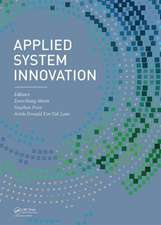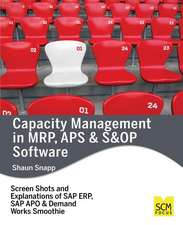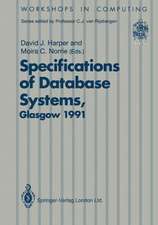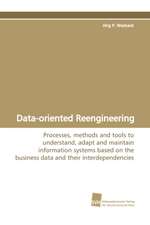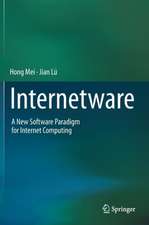Autonomic Computing: Principles, Design and Implementation: Undergraduate Topics in Computer Science
Autor Philippe Lalanda, Julie A. McCann, Ada Diaconescuen Limba Engleză Paperback – 28 mai 2013
Din seria Undergraduate Topics in Computer Science
- 20%
 Preț: 287.02 lei
Preț: 287.02 lei - 20%
 Preț: 316.24 lei
Preț: 316.24 lei - 20%
 Preț: 350.89 lei
Preț: 350.89 lei - 20%
 Preț: 227.15 lei
Preț: 227.15 lei - 20%
 Preț: 187.22 lei
Preț: 187.22 lei - 20%
 Preț: 280.92 lei
Preț: 280.92 lei - 20%
 Preț: 306.71 lei
Preț: 306.71 lei - 20%
 Preț: 318.97 lei
Preț: 318.97 lei - 20%
 Preț: 258.78 lei
Preț: 258.78 lei - 20%
 Preț: 226.64 lei
Preț: 226.64 lei - 20%
 Preț: 179.87 lei
Preț: 179.87 lei - 20%
 Preț: 395.04 lei
Preț: 395.04 lei - 20%
 Preț: 225.02 lei
Preț: 225.02 lei - 20%
 Preț: 272.43 lei
Preț: 272.43 lei - 20%
 Preț: 306.58 lei
Preț: 306.58 lei - 20%
 Preț: 287.22 lei
Preț: 287.22 lei - 20%
 Preț: 305.01 lei
Preț: 305.01 lei - 20%
 Preț: 384.11 lei
Preț: 384.11 lei -
 Preț: 334.88 lei
Preț: 334.88 lei - 20%
 Preț: 305.61 lei
Preț: 305.61 lei - 20%
 Preț: 375.53 lei
Preț: 375.53 lei - 20%
 Preț: 276.82 lei
Preț: 276.82 lei - 20%
 Preț: 342.45 lei
Preț: 342.45 lei - 20%
 Preț: 254.37 lei
Preț: 254.37 lei - 20%
 Preț: 237.35 lei
Preț: 237.35 lei - 20%
 Preț: 316.07 lei
Preț: 316.07 lei - 20%
 Preț: 374.37 lei
Preț: 374.37 lei - 20%
 Preț: 245.43 lei
Preț: 245.43 lei - 20%
 Preț: 233.75 lei
Preț: 233.75 lei - 20%
 Preț: 307.16 lei
Preț: 307.16 lei - 20%
 Preț: 374.20 lei
Preț: 374.20 lei - 20%
 Preț: 246.39 lei
Preț: 246.39 lei - 20%
 Preț: 237.62 lei
Preț: 237.62 lei - 20%
 Preț: 463.43 lei
Preț: 463.43 lei - 20%
 Preț: 297.28 lei
Preț: 297.28 lei - 20%
 Preț: 304.44 lei
Preț: 304.44 lei - 20%
 Preț: 579.37 lei
Preț: 579.37 lei - 20%
 Preț: 298.18 lei
Preț: 298.18 lei - 20%
 Preț: 302.80 lei
Preț: 302.80 lei - 20%
 Preț: 300.89 lei
Preț: 300.89 lei - 20%
 Preț: 191.35 lei
Preț: 191.35 lei - 20%
 Preț: 243.35 lei
Preț: 243.35 lei - 20%
 Preț: 297.66 lei
Preț: 297.66 lei - 20%
 Preț: 278.10 lei
Preț: 278.10 lei - 20%
 Preț: 389.96 lei
Preț: 389.96 lei - 20%
 Preț: 184.28 lei
Preț: 184.28 lei
Preț: 304.21 lei
Preț vechi: 380.26 lei
-20% Nou
Puncte Express: 456
Preț estimativ în valută:
58.22€ • 60.41$ • 48.66£
58.22€ • 60.41$ • 48.66£
Carte tipărită la comandă
Livrare economică 17-31 martie
Preluare comenzi: 021 569.72.76
Specificații
ISBN-13: 9781447150060
ISBN-10: 1447150066
Pagini: 294
Ilustrații: XV, 288 p. 88 illus.
Dimensiuni: 155 x 235 x 20 mm
Greutate: 0.43 kg
Ediția:2013
Editura: SPRINGER LONDON
Colecția Springer
Seria Undergraduate Topics in Computer Science
Locul publicării:London, United Kingdom
ISBN-10: 1447150066
Pagini: 294
Ilustrații: XV, 288 p. 88 illus.
Dimensiuni: 155 x 235 x 20 mm
Greutate: 0.43 kg
Ediția:2013
Editura: SPRINGER LONDON
Colecția Springer
Seria Undergraduate Topics in Computer Science
Locul publicării:London, United Kingdom
Public țintă
Upper undergraduateCuprins
Software Engineering to Autonomic Computing.- Autonomic Systems.- Sources of Inspiration for Autonomic Computing.- Autonomic Computing Architectures.- The Monitoring Function.- The Adaptation Function.- The Decision Function.- Evaluation Issues.- Autonomic Mediation in Cilia.- Future of Autonomic Computing and Conclusions.- Learning Environment.
Notă biografică
Dr. Philippe Lalanda is a professor of software engineering at the Joseph Fourier University, Grenoble, France.
Dr. Julie A. McCann is a Reader in Computer Systems at Imperial College London, UK.
Dr. Ada Diaconescu is a lecturer (maître de conférences) in the Department of Computing and Networks at Télécom ParisTech, France.
Dr. Julie A. McCann is a Reader in Computer Systems at Imperial College London, UK.
Dr. Ada Diaconescu is a lecturer (maître de conférences) in the Department of Computing and Networks at Télécom ParisTech, France.
Textul de pe ultima copertă
Autonomic computing is changing the way software systems are being developed, introducing the goal of self-managed computing systems with minimal need for human input.
This easy-to-follow, classroom-tested textbook/reference provides a practical perspective on autonomic computing. Through the combined use of examples and hands-on projects, the book enables the reader to rapidly gain an understanding of the theories, models, design principles and challenges of this subject while building upon their current knowledge; thus reinforcing the concepts of autonomic computing and self-management.
Topics and features:
This easy-to-follow, classroom-tested textbook/reference provides a practical perspective on autonomic computing. Through the combined use of examples and hands-on projects, the book enables the reader to rapidly gain an understanding of the theories, models, design principles and challenges of this subject while building upon their current knowledge; thus reinforcing the concepts of autonomic computing and self-management.
Topics and features:
- Provides a structured and comprehensive introduction to autonomic computing with a software engineering perspective
- Supported by a downloadable learning environment and source code that allows students to develop, execute, and test autonomic applications at an associated website
- Presents the latest information on techniques implementing self-monitoring, self-knowledge, decision-making and self-adaptation
- Discusses the challenges to evaluating an autonomic system, aiding the reader in designing tests and metrics that can be used to compare autonomic computing systems
- Reviews the most relevant sources of inspiration for autonomic computing, with pointers towards more extensive specialty literature
- Ideal for a 10-week lecture programme
Caracteristici
The first practical guide to autonomic computing for advanced students and researchers alike Presents classroom-tested examples and hands-on bounded projects that illustrate the concepts in a concrete fashion Provides software for a learning environment for developing, executing and testing autonomic applications

